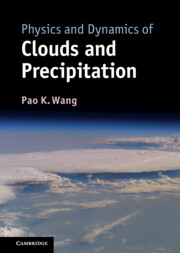Book contents
- Frontmatter
- Contents
- Preface
- 1 Observation of clouds
- 2 The shape and size of cloud and precipitation particles
- 3 Molecular structures of water substance
- 4 Bulk thermodynamic equilibrium among water vapor, liquid water, and ice
- 5 Surface thermodynamics of water substance
- 6 Aerosol in the atmosphere
- 7 Nucleation
- 8 Hydrodynamics of cloud and precipitation particles
- 9 Diffusion growth and evaporation of cloud and precipitation particles
- 10 Collision, coalescence, breakup, and melting
- 11 Cloud drop population dynamics in the warm rain process
- 12 Fundamental cloud dynamics
- 13 Numerical cloud models
- 14 Cloud electricity
- 15 Clouds–environment interaction
- References
- Index
- Plate section
11 - Cloud drop population dynamics in the warm rain process
Published online by Cambridge University Press: 05 March 2013
- Frontmatter
- Contents
- Preface
- 1 Observation of clouds
- 2 The shape and size of cloud and precipitation particles
- 3 Molecular structures of water substance
- 4 Bulk thermodynamic equilibrium among water vapor, liquid water, and ice
- 5 Surface thermodynamics of water substance
- 6 Aerosol in the atmosphere
- 7 Nucleation
- 8 Hydrodynamics of cloud and precipitation particles
- 9 Diffusion growth and evaporation of cloud and precipitation particles
- 10 Collision, coalescence, breakup, and melting
- 11 Cloud drop population dynamics in the warm rain process
- 12 Fundamental cloud dynamics
- 13 Numerical cloud models
- 14 Cloud electricity
- 15 Clouds–environment interaction
- References
- Index
- Plate section
Summary
In Chapter 10, we discussed the collision, coalescence, breakup, and melting of individual water drops and ice particles. There we treated only the very short-time-interval event where only two particles are interacting. In a real cloud, there are a huge number of particles. A hydrometeor right after its inception will grow first by diffusion and, if it survives, will soon reach a size at which collision and coalescence may occur. It will interact with many other particles as time goes on. The time for such interaction to occur is very short and we can make an order-of-magnitude estimate of this time interval τ. For a small cumulus cloud with narrow drop size spectrum centered around 10 µm, the mean distance between cloud droplets is ~1000 µm (1 mm). For cloud drops to collide, they have to have different velocities. The terminal fall speed of a 10 µm radius drop is about 1 cm s−1. Therefore, if we assume that the typical velocity difference is ~1 mm s−1, then it takes about 1 s for a larger drop to interact with another drop. In other words, within τ ~ 1 s, we only need to consider the collision between two drops. However, for a time interval longer than τ, it will be necessary to consider the time evolution of such events.
If coalescence occurs, this hydrometeor will lose its identity and the cloud will have a new population of hydrometeors of different types, sizes, and number concentrations. Thus the population of hydrometeors evolves as a function of time and space. In this chapter we will discuss the time evolution of the hydrometeor population, mainly the evolution of the cloud particle size distribution as a function of time. Our focus will be on the evolution of the cloud drop size distribution because it is the simplest to understand. The evolution of other hydrometeors is much more complicated.
- Type
- Chapter
- Information
- Physics and Dynamics of Clouds and Precipitation , pp. 288 - 304Publisher: Cambridge University PressPrint publication year: 2013



